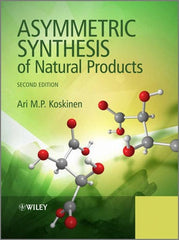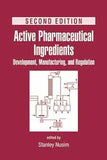Asymmetric Synthesis of Natural Products, 2nd Edition Ari M. P. Koskinen
Asymmetric Synthesis of Natural Products, 2nd Edition
Ari M. P. Koskinen
ISBN: 978-1-119-97669-1
322 pages
August 2012, ©2012
Description
Asymmetric Synthesis of Natural Products, 2nd Edition introduces students to this rapidly growing field of organic chemistry. The initial chapters present the foundations of asymmetric synthesis, including the theory and applications of individual asymmetric reactions. This is followed by chapters on each of the major individual classes of natural products; their structures, biosynthesis and interrelationships as well as examples of asymmetric syntheses and the practical value of these compounds. Natural product classes covered include carbohydrates, amino acids, peptides, proteins, nucleosides, nucleotides, nucleic acids, polyketides, isoprenoids, shikamic acid derivatives and alkaloids.
For this second edition the text has been thoroughly updated and expanded, and includes new discussions and examples covering atom and redox economies, practical aspects and environmental awareness. Organocatalysis has emerged completely in the last ten years, and has been fully integrated into this new edition.
Table of Contents
Preface to the First Edition ix
Preface to the Second Edition xi
List of Common Abbreviations xiii
1 Introduction 1
1.1 Some properties of natural products 4
1.2 Natural products as drugs 7
1.3 Structures of natural products 10
1.4 Asymmetric synthesis of natural products 15
1.5 Synthetic organic chemistry 17
References 20
2 Chirality, Topology, and Asymmetric Synthesis 23
2.1 The need for enantiopure compounds 34
2.2 Determination of enantiomeric purity 38
2.3 Chirality and thermodynamic principles of asymmetric induction 42
2.4 Methods for obtaining chiral compounds 44
References 52
3 Asymmetric Synthesis 55
3.1 Allylic strain 55
3.2 Reactions of the carbonyl group 59
3.2.1 Nucleophilic additions on the carbonyl carbon 59
3.2.2 Reactions at the α-carbon (enolate chemistry) 81
3.2.3 Reactions at the β-carbon of an enone 95
3.3 Reactions of olefins 99
3.3.1 Oxidation 99
References 108
4 Sugars 115
4.1 Monosaccharides 116
4.1.1 Aldoses and ketoses 116
4.1.2 Deoxy sugars 122
4.1.3 Amino sugars 122
4.1.4 Sugar alcohols 125
4.1.5 Acidic sugars 125
4.2 Polysaccharides 127
4.3 Glycoproteins and proteoglycans 131
4.4 Glycolipids 134
4.5 Sugar antibiotics 134
4.6 Cyclitols 138
References 142
5 Amino Acids, Peptides, and Proteins 145
5.1 Amino acids 145
5.2 Peptides and proteins 149
5.3 Enzymes and receptors 153
5.4 Chemical modifications of peptides 154
5.5 Biosynthesis of amino acids 156
5.6 Asymmetric synthesis of amino acids 160
5.6.1 α-Alkylation 162
5.6.2 Amination of ester enolates 167
5.6.3 Catalytic hydrogenation 169
5.6.4 Miscellaneous 170
5.6.5 Pepstatins 171
References 173
6 Nucleosides, Nucleotides, and Nucleic Acids 175
References 184
7 Polyketides 187
7.1 Biosynthesis 188
7.2 Fatty acids 190
7.2.1 Prostaglandins, thromboxanes, and leukotrienes 191
7.2.2 Sphingolipids 196
7.3 Polypropionates 200
7.3.1 Polyether antibiotics 200
7.3.2 Macrolides 201
7.3.3 Spiroketals 209
7.4 Aromatic polyketides 213
References 215
8 Terpenes 219
8.1 Terpenes 221
8.1.1 Monoterpenes 221
8.1.2 Sesquiterpenes 223
8.1.3 Diterpenes 228
8.1.4 Higher terpenes 230
8.2 Carotenoids 234
8.3 Steroids 235
8.3.1 Biosynthesis of steroids 240
8.3.2 Asymmetric synthesis of steroids 242
References 244
9 Shikimic Acid Derivatives 247
9.1 Case synthesis: Oseltamivir 251
References 254
10 Alkaloids 257
10.1 Heterocyclic alkaloids 258
10.1.1 Indole alkaloids 259
10.1.2 Pyrrolidine and tropane alkaloids 270
10.1.3 Quinoline and isoquinoline alkaloids 273
10.1.4 Izidine alkaloids 279
10.2 Alkaloids with exocyclic nitrogen 282
10.3 Polyamine alkaloids 283
10.4 Peptide alkaloids 283
10.5 Terpene alkaloids 284
References 285
Index 289


















